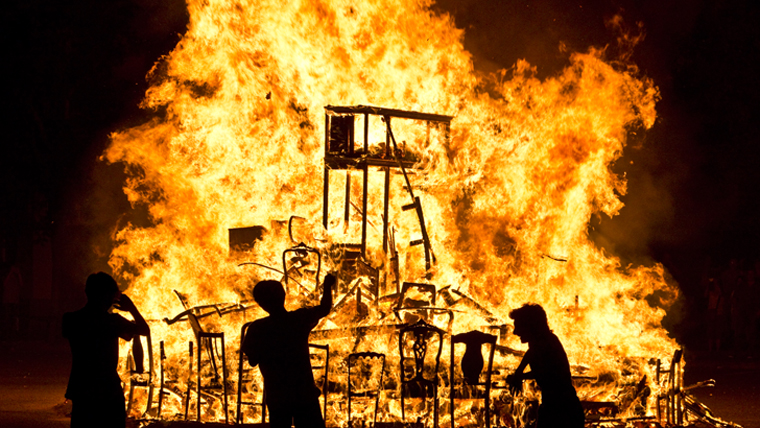23.06.2020 - 11:06
|
Actualització: 23.06.2020 - 13:06
Sant Joan’s eve, the night before June 24, is best known in Catalonia as a celebration of fire: bonfires, fireworks and solemn torches lit from a flame that never goes out. It closely coincides with the Summer Solstice or Midsummer Night, celebrated all over the world and for thousands of years with flames to usher in a new season, symbolizing purity and cleansing.
Bonfires, or ‘fogueres,’ are lit throughout towns and cities in contained safe areas, as well as on the beach, gathering crowds around them. Of course, COVID-19 will mark this year’s celebrations as large gatherings are not allowed and special security measures apply. However, fireworks have already sounded in Catalonia for days, specially after sundown, including flares, bangers, airbombs, roman candles, black cats, catherine wheels, snaps and all kinds more.
People use to gather on balconies and rooftops to watch the display. If not, events take place in squares, often involving ‘correfocs,’ or ‘fire-runners,’ people dressed as devils brandishing torches spewing fireworks and sparks. In fact, this is an important day for Catalonia’s firework sector. The association representing Catalonia’s firework makers and retailers projects sales around 18 million euros every year. The average household spends around 40 euros on fireworks.
The Flame of Canigó
A more solemn occasion is the Flama de Canigó, a flame that never goes out as it is kept lit the whole year in Perpignan. On June 22, it’s taken to the summit of the massif of Canigó ansd at midnight the journey begins and it’s distributed all throughout Catalonia.
This ritual was inspired by a poem of the same name, and was started in the mid ‘50s by Francesc Pujades. Despite the dictatorship, it spread and survived as a symbol of the resilience of Catalan culture. In the Catalan capital, the fire is received solemnly in the Plaça de Sant Jaume, in front of the City Council.
Outside of the capital, a version of the Sant Joan bonfires are falles, which in Catalonia refers to a mountain tradition of holding a parade in traditional dress and carrying a lit log on one’s shoulder down the mountain and adding it to a pyre.
Water, herbs and food
Sant Joan is far from being just incendiary. Three symbols mark the importance of the festival as well as fire: water and herbs also play an important role. Water symbolizes healing, leading many to bathe in the sea. Herbs, meanwhile, are for remedy, and some claim that on this night, their properties are even stronger.
The Coca de Sant Joan is a sweet flatbread that’s tradition to eat before the party, made with cream, nuts, or candied fruit – giving it a bejeweled look. There’s a myriad of variations, but the ingredient they all contain is anis.


